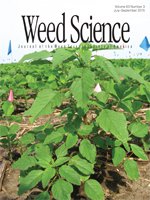Glyphosate is used in the transition zone to control annual bluegrass in fully dormant warm-season grasses. A suspected resistant (R) biotype of annual bluegrass was identified on a golf course in South Carolina after at least 10 consecutive years of glyphosate application. Greenhouse bioassays revealed the R biotype was 4.4-fold resistant to glyphosate compared with a standard susceptible (S) biotype. Further studies were conducted to investigate the mechanism conferring glyphosate resistance in the R biotype. Leaf discs of both biotypes accumulated shikimate in response to increasing glyphosate concentration, but the glyphosate concentration resulting in 50% EPSP synthase inhibition as a result of shikimate accumulation (I50) was 4.2-fold higher in the R biotype compared with the S biotype. At the whole plant level, similar levels of shikimate accumulation were observed between biotypes at 6 and 24 h after treatment (HAT) with glyphosate, but greater shikimate accumulation occurred in the S biotype at 72, 120, and 168 HAT. Shikimate levels decreased in the R biotype after 72 HAT. There were no differences in 14C-glyphosate absorption between biotypes. However, more 14C-glyphosate translocated out of the treated leaf in the R biotype and into root tissues over time compared with the S biotype. Partial sequencing of the EPSP synthase gene revealed a point mutation that resulted in an Ala substitution at Pro106. Although other mechanisms may contribute to glyphosate resistance, these results confirm a Pro106 to Ala substitution is associated with resistance to glyphosate in the R annual bluegrass biotype.
Nomenclature: Glyphosate; EPSP, 5-enolpyruvyl-shikimate-3-phosphate; shikimate, (3R,4S,5R)-3,4,5-trihydroxycyclohex-1-ene-1-carboxylic acid; annual bluegrass, Poa annua L.





